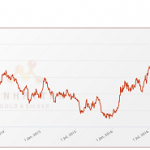PGMs, or platinum group metals, are a “family” of precious metals that have similar physical and chemical properties, and tend to occur together in the same mineral deposits. There are six PGMs in total, and all of them are precious metals. However, our refinery only works with two of them: platinum and palladium. In this post, we’ll go over the other four PGMs and examine their unique properties and applications.
Rhodium
Jewelers are probably more familiar with rhodium than most people. It is quite durable and extremely shiny – which makes it an excellent plating material. White gold and sterling silver jewelry is often electroplated with a layer of rhodium to increase durability, luster, and resistance to tarnish.
Ruthenium
Ruthenium is typically added to platinum or palladium alloys to increase their hardness for applications such as wear-resistant electrical contacts and thick-film resistors. Similarly, ruthenium can also be added to gold jewelry to increase its durability.
Osmium
Approximately twice as dense as lead, osmium the densest natural element on earth. Like lead, it’s also extremely toxic. Unlike lead, it’s the rarest stable natural element on earth. Osmium is usually alloyed with other metals for applications that require extreme density and hardness.
Iridium
Osmium narrowly beats iridium for the title of densest metal. However, iridium takes the crown for the most corrosion resistant metal. Any industrial application that needs heavy-duty corrosion resistance will use a little bit of iridium alloy. Although rare on earth, iridium is abundant in asteroids.











